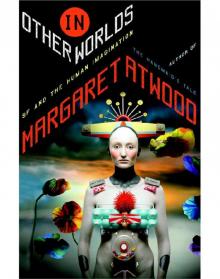- Home
- Margaret Atwood
In Other Worlds Page 3
In Other Worlds Read online
Page 3
Our ability to conceive of imaginary places—a somewhere that isn’t immediately tangible in the way that the dinnertime pork chop is tangible—appears very early in our individual lives. At first—when we’re extremely young—it’s a case of out of sight, out of mind: objects hidden from our view simply disappear, then appear again. It takes us a while to figure out that the rubber duck that went behind the curtain is still somewhere rather than nowhere.
Once we’ve decided things go to another place rather than simply ceasing to exist, we find it hard to shake that notion. Being “here,” then suddenly not being here: is that where the concepts of, for instance, afterlives and teleportation originate? Does Star Trek’s Scotty derive his ability to beam people up from the discovery that the rubber duck in our early games of peek-a-boo was still there really? Is dead Granddad floating around in the spirit world trying to get in touch with us? And will we, too, float around in that way, since it is very hard to picture the self as being nowhere at all? Surely the dead go somewhere, other than the tomb. Once, they went to the Egyptian Afterlife to get their souls weighed, or to the Fields of Asphodel, or up into the sky to become constellations, or to a physical location called Heaven. Now, perhaps, they might go to the Planet Krypton or wherever it is that E.T. went. And are the Fields of Asphodel and the Planet Krypton more or less the same place?
One method of approaching Other Worlds would be to trace their literary lines of descent—from the Mesopotamian underworld to the Egyptian Afterlife to the Domain of Pluto to the Christian Hell and Heaven to the Utopia of Sir Thomas More to the Islands of the Houyhnhnms and Dr. Moreau, and finally to Planet X and Gethen and Chiron. But Other Worlds have existed in many cultures, within which they can trace many separate literary and cultural lines of descent. Could it be that the tendency to produce such worlds is an essential property of the human imagination, via the limbic system and the neocortex, just as empathy is?
THE OUTFITS
Once upon a time, superhuman beings wore robes, like angels, or nothing, like devils, but the twentieth-century superhero outfit has more proximate fashion origins. The skin-tight clothing with the bathing suit over the abdominal parts, the wide, fancy belt, and the calf-high boots most probably derive from archaic turn-of-the century circus attire, especially that of high-wire artists and strongmen. (With pleasing circularity, the stars of World Wide Wrestling now dress up in costumes similar to those of comic-book characters whose own colourful and six-pack-disclosing attire recalls that of earlier bemuscled showmen.)
The cape may descend from the knights so prominent in the Pre-Raphaelite art that would have been familiar to the originators of these figures, or—closer to hand—from stage magicians, or, at a stretch, from Bela Lugosi as Dracula, in the black-and-white film of that name, back when vampires were vile and smelled bad rather than being sparkly in the sunlight and love’s young dream, as they seem to have become today. There was also the Cloak of Invisibility that featured in old folk tales, resurfaced in modern scientific-discovery dress in Wells’s Invisible Man, made a reappearance in its original magic form in the Harry Potter books, and became a new kind of camouflage material in William Gibson’s Neuromancer. But none of the early 1940s comic-book superheroes had a Cloak of Invisibility, probably because it was hard to draw a picture of a person being invisible. (The closest we come is perhaps Wonder Woman’s transparent helicopter, indicated by a dotted line.)
The mask was not obligatory for superheroes: neither Superman nor Captain Marvel needed such an identity-concealer, as each had a whole other body to slip into. (Clark Kent’s ability to peel off his reporter suit in a phone booth and suddenly expand into someone a great deal bigger and more muscular, like one of those dried-gel Santa Clauses you drop into water, was never adequately explained.) Batman’s mask may have come from the commedia dell’arte tradition, or from knights-incognito such as Ivanhoe. Or—and these are more sinister origins—from the Phantom of the Opera, or from Fantômas, a masked and also French evil genius from the turn of the century. Or possibly just from the standard masked robber of the comics. As Batman himself was mortal and did not transform from one bodily shape into another, you can see why he would need a mask.
Outfits—or special costumes and regalia—are of course very old. We are familiar with ceremonies such as university graduations—you are presented with a hood item or hat or scroll, and thus become something you weren’t before. At the investiture ceremonies of popes, the new pope is given the Fisherman’s Ring, the wearing of which grants him, in the eyes of believing others, a huge amount of spiritual power that the individual man would not have without this symbol. (Rings have had special abilities for a long time; see the magic rings in One Thousand and One Nights, as well as Richard Wagner’s Ring Cycle and J. R. R. Tolkien’s not unrelated The Lord of the Rings, both of which draw on much earlier traditions.) In coronations, the magic items are the crown and the sceptre: they embody the role of king, as the king was once thought to embody the realm he ruled. The further back you go, the more significant the objects worn or carried become. In the age of the god-kings, such as those of ancient Egypt or Sumer, the man or woman and the costume and regalia were almost one and the same: you were the role, and the role was the garment and its embellishments. You inhabited it rather than just wearing it.
Consider the oldest poem we know anything about, the Mesopotamian cycle sometimes called “Inanna’s Journey to Hell.” In it, the life-goddess Inanna descends to the Underworld to confront her sister, the goddess of death, Ereshkigal. To defend herself during the trip, Inanna puts on and carries an astonishing number of talismanic and powerful objects: the special sandals, the seven insignia, the desert crown, a queenly wig, a rod, a number of gems, two pectorals, a golden ring, some face makeup, and a robe of sovereignty. But the laws of the Underworld say that she must give up each one—you couldn’t take it with you, even then—and when all her protective charms are gone, she’s naked; whereupon she dies and is hung up on a spike. For every Achilles there’s a heel, a condition of vulnerability; for every Superman there’s a kryptonite, a force that negates special powers.
The Mesopotamian story does have a somewhat happy outcome. Inanna is the goddess of life and reproduction, so it would be a catastrophe for her to remain in the land of the dead. But no mortal can be sent to the Underworld to resurrect her with the Water of Life, since any mortal who goes there will die; so the god Enkil makes two non-human beings from the dirt beneath his fingernails and sends them down instead, thus giving us—we might say—the ancestors of Golems, and statues that come to life, and, ultimately, robots. We are not told that on her journey back to the upper world Inanna regains all her regalia, but it must have been so because later in the poem she is again wearing her crown of authority.
How much older than Mesopotamia is the connection between special clothing and talismans and heightened powers? Quite a lot older. Some of the very few human figures in Paleolithic cave paintings are in fact semi-human: they are thought to be shamans who by putting on the skins and horns of animals become part animal themselves, and thus able to join the animals in thought, to determine their whereabouts, and perhaps to ask them to make a gift of their bodies to the hungry tribe.
It’s the outfit and the ritual associated with it that embodies the shamanistic power. The shamans of hunter-gatherers lived with the community, not in a palace or temple. Most of the time they went about their daily lives like everyone else, but when occasion required it they transformed themselves into their magic alter egos in order to serve the community. There’s an Australian Aboriginal film called Ten Canoes, set in pre-contact days, in which we can see this transformation taking place. The shaman’s powers are needed; he steps behind some bushes and emerges in full body paint, ready for magic. He is two people: his ordinary self and his other self, powerful in extraordinary ways, and able to travel between the seen and the unseen. His special decoration, just like Captain Marvel’s, is a signal to the watchers t
hat he is in his altered state.
THE DOUBLE IDENTITY
The doubleness of superheroes thus has a very long ancestry. But more immediate ancestors abound in the period just preceding the advent of the comic book.
In nineteenth-century fiction, doubles are plentiful, as they are, indeed, in nineteenth-century opera and ballet—think of the white and black swan princesses of Swan Lake. Stevenson’s Dr. Jekyll and his shorter, younger, and hairier double, the nasty Mr. Hyde, Wilde’s Dorian Gray and his diseased and corrupt Picture, and Poe’s William Wilson and his taunting twin are among the best-known literary examples. Some speculate that such good/bad pairs may have at least some roots in the lives of real people—such as Jonathan Wild the thief-taker, whose secret life was as a mastermind of crime, or Deacon Brodie of Edinburgh, a respectable gentleman whose midnight misdeeds are thought to have inspired Stevenson.
But these are sinister doubles. For the weak or frivolous alter ego acting as a front for the strong, virtuous hero—more like Clark Kent and Superman—we should most likely be looking at the Scarlet Pimpernel—dithering fop by day, steel-nerved rescuer by night—and possibly even Alexandre Dumas’s The Count of Monte Cristo, in which the hero assumes several aliases—including that of an eccentric English lord—in order to reward virtue and punish crime. Sherlock Holmes, that supreme intellect, clue-tracker, and criminal-hunter, was a master of disguise, often posing as someone less than he really was: a feeble, kindly old clergyman, for instance, or an out-of-work groom.
In addition to his disguising “normal” alter ego, the superhero of the 1940s was required to have a powerful enemy or two. Carl Jung made no secret of the fact that he based much of his mapping of the psyche on literature and art. For instance, his theory of the “Shadow”—that dark double of the Self—has a great deal in common with, for instance, The Tales of Hoffmann, or indeed any of the “double” narratives I’ve already mentioned. A comic-book character leading a split life and engaged in a battle between Good and Evil might well be expected to show Jungian characteristics, and in fact Batman is an almost perfect case study.
Batman has three main enemies, who to a Jungian would obviously be projections of Bruce Wayne that Wayne himself has not come to terms with. (In Blakean terms, the two male enemies would be called his Spectres and the female one might be his Emanation.) For Bruce, the female element is conflicted—he’s a confirmed bachelor, and has no nice-girl Lois Lane sentimental figure in his life. But the sinuous and desirable Catwoman with whom he frequently skirmishes must be his Jungian “dark anima” figure: even a child could recognize that there was a lot of unresolved electricity going on between those two.
The sadistic card-playing Joker, with his sinister-clown appearance, is Batman’s Jungian Shadow—his own interest in dress-ups and jokes turned malicious. There’s another Shadow villain—the Penguin—who wears an outfit reminiscent of period cartoons of capitalists, with spats, cigarette holder, and top hat. His civilian alias even has a three-barrelled, pretentious, old-plutocrat faux-English name: Oswald Chesterfield Cobblepot. The Penguin is the “rich” side of playboy Bruce Wayne gone rancid.
Then there’s Robin, the Boy Wonder, who is Bruce’s ward. Is Bruce gay? Don’t even think about it. From the point of view of we mythosophists, Robin is an elemental spirit, like Shakespeare’s Puck and Ariel—note the bird name, which links him to air. His function in the plot is to aid the benevolent master trickster, Batman, with his plans. From the point of view of we Jungians, however, Robin is a Peter Pan figure—he never grows up—and he represents the repressed child within Bruce Wayne, whose parents, you’ll recall, were murdered when he was very young, thus stunting Bruce’s emotional growth.
This is the kind of hay, or perhaps hash, that can be made of such comic-book superheroes once you really get going. Both they and Jung himself can be viewed through Hoffmannesque magic spectacles and seen to be part of the same mythology.
But from the point of view of we kids—the primary readers—Robin was simply ourselves—what we would be if we, too, had masks and capes and could go running around in them under the delusion that nobody would know who we were, and—better still—stay up long after our bedtimes, allowed to participate in the doings of what we fondly hoped was the adult world.
THE FLYING
Batman couldn’t really fly. This must have dampened my view of him somewhat, since—judging from the pictorial evidence—flying was the superhero attribute that interested me the most during my days as a child superhero cartoonist. Almost everything in my created world of Mischiefland was airborne. Why was I so keen on the life of the air? Come to think of it, why were the creators of the superheroes so keen on it as well?
The interest appears to be widespread. One of the recent—though minor—superheroes I’ve come across is named Kidney Boy. I picked him up on the Internet micro-blogging site Twitter, and, intrigued by his nom de plume, I offered to design a superhero outfit for him, complete with special powers and charm-word. In real life, Kidney Boy has a somewhat geeky alter ego—he’s a nephrologist, or kidney doctor. He told me he would love to have a magic power, one that would allow him to create new kidneys that would be perfect matches for his dialysis patients. But if he couldn’t have that, he said, could he please have “the flying-around thing”?
In the event, I provided everything he wanted: an outfit with a purple kidney helmet; a magic scalpel that would never fail; a magic word—Nephro-Change-O!—that would not only create the desired kidneys but cause them to slide effortlessly into his patients without even an incision; and, to top it all off, “the flying-around thing.”
Kidney Boy by Margaret Atwood:
Ontogeny repeats phylogeny—could Kidney Boy and I both have inherited this interest in flying? Is it inscribed in our genes, or is it the result of a meme, of the kind popularized by Richard Dawkins—a theme, idea, or motif passed down from generation to generation, self-replicating, mutating, and competing with other memes as it goes? In either case, it’s surely no accident that the ability to fly, with or without the aid of wings, flying shoes or capes or horses or carpets, balloons, aerodynamic kidneys, and so forth, has a very long history.
What does the ability to fly portend, in a superhero or even a god? We are not talking here about airplanes and helicopters: the flying-around thing is not about more rapid and efficient real-life transportation methods. It has to do with wings, either actual or implied, with rising above the earth, and with the ability to glide effortlessly from one place to another. It has to do with overcoming the restrictions of the body, that dead weight of ultimate mortality we lug around with us. “If I had the wings of an angel,” mourns the old folk song, “over these prison walls I would fly …” We don’t have them. But it seems we’ve always wanted them.
At first glance, you might think that wings are an unconditionally good thing. In fact, wing-possession in a non-human being is an alarm signal.
For instance: Inanna, the life-and-sex goddess of Mesopotamia already mentioned, was shown with wings, but she was definitely an entity you wouldn’t want to get tangled up with. Both she and her later incarnation, Ishtar—who appears in The Epic of Gilgamesh—were travellers between realms—Earth to the Underworld, Earth to Heaven—and both were known for seducing mortal men who then met tragic fates. When Ishtar asks Gilgamesh to be her husband, he recites a long list of her former lovers whom she has killed or tortured or turned into wolves or dwarfs.
The Greeks had two messenger gods: Iris, a morally neutral figure who had golden wings, and Hermes, who governed communications (thus justifying his handsome, curly-headed appearance on the Bell telephone books of the 1940s, with his traditional winged helmet and sandals, but with a modern touch—a number of thick telephone cables wrapped modestly around his midsection). Hermes was also the god of travellers and as such conducted the souls of the dead to the Underworld, so going with him on a journey was not always a fortunate thing to do. There was also Nike, thought of as the
Goddess of Victory, but perhaps more accurately the goddess who announces victory—another messenger. She, too, had wings. But victory for one side, as we know, always means defeat for the other.
In the Judeo-Christian tradition, messengers from the divine realm are called “angels,” which is simply the Greek word for “messenger.” The Hebrew word has the same meaning. In the Bible, angels are not often described as having wings; more usually they appear as human beings, though the seraphim in Isaiah: 6 have six wings and some New Testament angels evidently have the power of flight and/or instant teleportation. For their appearances in later art, the two-winged angel images most likely filched their wings from Nike or Iris, or, for the young cherubs, from Eros, the boy-god of love. But whether wingless or not, angels certainly illustrate the troubling nature of messengers. How much fun is it to be told that your hometown is about to be destroyed by fire and brimstone, or that you, an unmarried virgin, are about to get pregnant? The expressions on the faces of Renaissance Virgin Marys are usually ones of apprehension, not joy. A visit from Iris or Hermes or any Judeo-Christian angel messenger was as likely to be bad news as good.
Thus the fact that such divine beings can fly should not necessarily make us trust them. Like the utterings of oracles, the messages they bring are often deeply ambiguous.

 Surfacing
Surfacing Hag-Seed
Hag-Seed Oryx and Crake
Oryx and Crake The Heart Goes Last
The Heart Goes Last The Handmaid's Tale
The Handmaid's Tale Lady Oracle
Lady Oracle Good Bones and Simple Murders
Good Bones and Simple Murders The Robber Bride
The Robber Bride Life Before Man
Life Before Man Alias Grace
Alias Grace The Blind Assassin
The Blind Assassin Cat's Eye
Cat's Eye The Testaments
The Testaments The Penelopiad
The Penelopiad MaddAddam
MaddAddam Dancing Girls & Other Stories
Dancing Girls & Other Stories On Writers and Writing
On Writers and Writing Selected Poems II (1976-1986)
Selected Poems II (1976-1986) Wilderness Tips
Wilderness Tips Dearly
Dearly The Tent
The Tent Bluebeard's Egg
Bluebeard's Egg The Edible Woman
The Edible Woman The Penelopiad: The Myth of Penelope and Odysseus
The Penelopiad: The Myth of Penelope and Odysseus Good Bones
Good Bones I Dream of Zenia with the Bright Red Teeth
I Dream of Zenia with the Bright Red Teeth Circle Game
Circle Game Choke Collar: Positron, Episode Two
Choke Collar: Positron, Episode Two Stone Mattress: Nine Tales
Stone Mattress: Nine Tales The MaddAddam Trilogy
The MaddAddam Trilogy Stone Mattress
Stone Mattress Power Politics
Power Politics MaddAddam 03 - MaddAddam
MaddAddam 03 - MaddAddam I’m Starved for You (Kindle Single)
I’m Starved for You (Kindle Single) Murder in the Dark
Murder in the Dark In Other Worlds
In Other Worlds Dancing Girls
Dancing Girls Moral Disorder
Moral Disorder